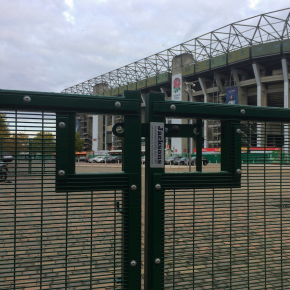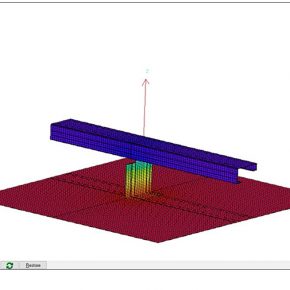
A best practice guide to specifying manual and automated gates
Well maintained, properly installed gates and barriers play an essential part of the physical security of a business or organisation. Should these malfunction, whether by poor design, installation or inadequate maintenance, the results can be catastrophic and can lead to injury, loss of limb or even fatalities. Specifying safe access control is a complex process, in addition to the wide variety of gates and barriers available there is also legislation that needs to be complied with.
Little wonder so much confusion exists around gates and their suitability. With so much at stake it is critical to specify correctly.
Here, Jacksons Fencing, the security fencing experts, outline some of the points to be considered when specifying gates and barriers to ensure sites are safe, secure and able to operate efficiently.
Understanding the gate you need through risk assessment
Typically, the first step in the process of specifying gates or barriers is to carry out a comprehensive risk assessment that considers both current and long-term site use.
As would be expected, consulting drawings and plans is an essential part of the process in establishing what forms of access control are needed. Beyond this, it is equally important to visit the site in person. This will give a first-hand understanding of how operational and safety considerations will affect the proposed area for the gate or barrier. It also allows you to consider aspects not necessarily included in a specification brief or images of the site, such as uneven ground, site levels, space restrictions, wind loading and more.
Regulations and legislation for access control
Due to the potential risks posed by malfunctioning or poorly installed gates, current regulations and legislation should be consulted. The applicable regulations will vary dependent on whether manual or automated access operation is selected.
Manual swing gates and barriers are designed to operate freely but can still be large and heavy. They are the most popular type for both pedestrian and vehicle access, as they are proven, simple and cost effective. However, if left unchecked and without mechanical devices holding them in both open and closed positions, they can become dangerous. It is worth reviewing all options in line with the risk assessment prior to specifying a manual gate or barrier to ensure both safety and security requirements are met.
The benefits from an automated gate often outweigh the higher initial cost. Automated gates typically employ electric motors or hydraulic rams and provide convenience and security. But they also require routine maintenance and must comply with legislation.
For manual gates and barriers, there is little in the way of specific guidance, best practice and legislation specifically relating to their installation or operation. However, various standards have relevant elements which can be applied. These are BS 5709:2006 (which covers gaps, gates and stiles) and BS EN12604:2000 (which covers doors, gates and barriers). In addition, BS EN 6180:2011 gives recommendations and guidance for the construction of barriers in and around buildings.
Lack of specific legislation makes manual gates and barriers easier to specify. However, it does shift the burden of responsibility squarely onto the shoulders of the specifier to ensure the choice is both safe and fit for purpose.
Automated gates and barriers are required to comply with EU Machinery Directive 2006/42/EC as implemented by the UK‘s Supply of Machinery Regulations 2011. As automated gates and barriers are classed as machinery they must also be CE marked. To meet these regulations correct installation and regular maintenance is required.
It is also worth noting that a fully automatic gate should feature a minimum of two types of safety device. The first being photocells, the other could be pressure edges or protection through the limitation of the forces that operate the gate.
Best practice
Jacksons Fencing has compiled all the necessary information for a best practice approach to access control and has created the handy Guidance on Specifying Manual and Automated Gates and Barriers. The free downloadable document gives specifiers the information needed to specify with confidence, saving time that would otherwise be spent sifting through numerous other sources.
We also advise looking out for the ‘Gate Safe Aware’ logo on products and services as this indicates that engineers and technical advisors have passed an in depth training course to ensure they are up to date with the very latest standards and guidance for the installation and maintenance of automated gates.
Jacksons Top Ten Tips on Safe and Secure Access Control
- Always be in position to know who has entered a site and where they are at any given time
- Minimise the number of entrances to a site but ensure the site is accessible to all users
- Keep pedestrians and vehicles safely apart
- Ensure emergency vehicles have adequate access and the site can be rapidly evacuated in the event of a major incident
- For safety, ensure gates and barriers are able to be held securely in the open position
- If using electronic access control ensure devices are not relying on IP connectivity to operate as this could leave them vulnerable to hackers
- Consider if gate locking and latching hardware is required on both sides. Ideally these should be inaccessible from the ‘attack’ side
- Gates need to be fitted to prevent entry and egress under its structure. Hinges need to be designed to prevent the gate from being lifted free. Gate locks and ground bolts need to be shielded to prevent them being used as steps to scale the gate or adjoining fencing or walls
- Gates should be the same height as adjoining fencing, and if used to provide a security barrier, should be a minimum of two metres high
- Design and specify gates and barriers for their intended purpose and in context with the risk assessment, the anticipated duty cycle and operations of the site
Latest news

26th July 2024
Enfield Speciality Doors completes world-class project for Atlas Copco HQ
A rundown office and warehouse building completely transformed into a modern headquarters for Atlas Copco has been fitted with more than 120 internal fire doors from Enfield Speciality Doors.
Posted in Access Control & Door Entry Systems, Articles, Building Industry News, Building Products & Structures, Building Systems, Case Studies, Doors, Interior Design & Construction, Interiors, Posts, Restoration & Refurbishment, Retrofit & Renovation, Security and Fire Protection, Sustainability & Energy Efficiency, Timber Buildings and Timber Products, Wooden products
26th July 2024
Abloy UK launches new white paper
Abloy UK, a leading provider of security and access control solutions, has launched a new white paper.
Posted in Access Control & Door Entry Systems, Architectural Ironmongery, Articles, Building Industry News, Building Products & Structures, Building Services, Doors, Facility Management & Building Services, Health & Safety, Information Technology, Innovations & New Products, Publications, Research & Materials Testing, Security and Fire Protection
26th July 2024
MCRMA Member Profile: David Roy, Director of Roofconsult
David Roy of MCRMA member company Roofconsult has more than 50 years’ experience to draw upon working in the building envelope sector and a unique perspective on how it has changed in that time.
Posted in Articles, BIM, Infrastructure & CAD Software, Building Associations & Institutes, Building Industry News, Building Products & Structures, Building Services, Building Systems, Cladding, Information Technology, Restoration & Refurbishment, Retrofit & Renovation, Roofs, Walls
26th July 2024
Strand: Enhancing Door Functionality and Safety
Craig Fox, Sales Director for Strand Hardware, outlines how door industry professionals might apply door limiting stays…
Posted in Architectural Ironmongery, Articles, Building Industry News, Building Products & Structures, Building Services, Doors, Facility Management & Building Services, Health & Safety, Restoration & Refurbishment, Retrofit & Renovation
 Sign up:
Sign up: